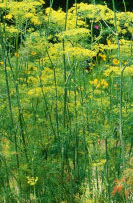 You probably don’t spend much time worrying about evil spirits and witches but when Halloween rolls around it is always nice to know that you are protected. There are numerous herbs that can do the job and some of them are familiar garden plants. They all have other uses, of course, and are worth growing for a variety of reasons. Still, it’s nice knowing that you are protected, just in case.
You probably don’t spend much time worrying about evil spirits and witches but when Halloween rolls around it is always nice to know that you are protected. There are numerous herbs that can do the job and some of them are familiar garden plants. They all have other uses, of course, and are worth growing for a variety of reasons. Still, it’s nice knowing that you are protected, just in case.
Here are five herbs that have traditionally been thought to ward-off evil spirits and witches.
 Angelica (Angelica archangelica)
Angelica (Angelica archangelica)
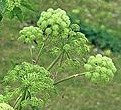 The name is enough to give you confidence that you are in a heavenly place. In the Middle Ages peasants made necklaces of the leaves for their children to wear as protection. They made Carmelite water from the juice of the roots to ensure a long life, free from the harm of witch’s spells.
The name is enough to give you confidence that you are in a heavenly place. In the Middle Ages peasants made necklaces of the leaves for their children to wear as protection. They made Carmelite water from the juice of the roots to ensure a long life, free from the harm of witch’s spells.
Type:
-
- Perennial
Height:
-
- 5-8”
Flowering:
-
- Summer
Light:
-
- Partial shade
Soil:
-
- Fertile, moist, well-drained, pH 6.3
Hardiness:
- Zones 3-8
 Betony (Stachys officinalis)
Betony (Stachys officinalis)
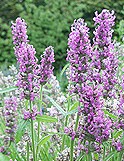 Best known for its use as tea, betony has been known since ancient times as a cure for a multitude of ills. People in the Middle Ages planted it in churchyards and wore amulets of it to ward-off evil spirits. If no evil spirits threaten you can just enjoy the beautiful flowers.
Best known for its use as tea, betony has been known since ancient times as a cure for a multitude of ills. People in the Middle Ages planted it in churchyards and wore amulets of it to ward-off evil spirits. If no evil spirits threaten you can just enjoy the beautiful flowers.
Type:
-
- Perennial
Height:
-
- Up to 3’ depending or variety
Flowering:
-
- Mid- to late summer
Light:
-
- Full sun to partial shade
Soil:
-
- Average, moderately moist, well-drained
Hardiness:
- Zones 4-8
 Dill (Anethum graveolens)
Dill (Anethum graveolens)
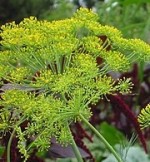 Aside from being a beautiful garden plant and delicious with fish and cucumbers, dill was used in the Middle Ages as one of the St. John’s Eve herbs against witchcraft. The “evil eye” could be avoided by carrying a bag of dried dill over the heart.
Aside from being a beautiful garden plant and delicious with fish and cucumbers, dill was used in the Middle Ages as one of the St. John’s Eve herbs against witchcraft. The “evil eye” could be avoided by carrying a bag of dried dill over the heart.
Type:
-
- Annual
Height:
-
- 3-5’
Flowering:
-
- Summer
Light:
-
- Full sun
Soil:
-
- Moderately rich, moist, well drained, pH 6.0
Hardiness:
- Zones 4-9
 Mugwort (Artemisa vulgaris)
Mugwort (Artemisa vulgaris)
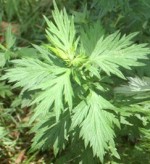 The Chinese use mugwort against evil spirts during the time of the Dragon Festival and the Europeans wore crowns of it on St. John’s Eve during the Middle Ages for the same reason. The deeply cut leaves of mugwort are attractive especially those of variegated and gold-leaf varieties.
The Chinese use mugwort against evil spirts during the time of the Dragon Festival and the Europeans wore crowns of it on St. John’s Eve during the Middle Ages for the same reason. The deeply cut leaves of mugwort are attractive especially those of variegated and gold-leaf varieties.
Type:
-
- Perennial
Height:
-
- To 6’
Flowering:
-
- Summer
Light:
-
- Full sun
Soil:
-
- Average to poor, well-drained
Hardiness:
- Zones 5-8
 Rue (Ruta graveolens)
Rue (Ruta graveolens)
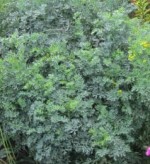 If you grow rue you probably prize it for its blue-green foliage but it has been associated with witchcraft as an antimagical herb since ancient Greek days. People in the Middle Ages used it as protection from witches’ spells and to ward off the plague. You might recognize the shape of the rue leaves as they were a model for the suit of clubs on playing cards.
If you grow rue you probably prize it for its blue-green foliage but it has been associated with witchcraft as an antimagical herb since ancient Greek days. People in the Middle Ages used it as protection from witches’ spells and to ward off the plague. You might recognize the shape of the rue leaves as they were a model for the suit of clubs on playing cards.
Type:
-
- Perennial
Height:
-
- 2- 3’
Flowering:
-
- Early summer but grown for foliage
Light:
-
- Full sun
Soil:
-
- Poor to moderate, well-drained, alkaline
Hardiness:
- Zones 4-9
Whether you believe in witches and evil-spirits or not, all of these herbs make good garden plants. Betony has outstanding blue flowers, while dill adds airiness with both flowers and foliage. Rue, especially the cultivar ‘Jackman’s Blue’ , has outstanding foliage and is a great plant for a knot garden. Use a golden or variegated form of mugwort for season long color. For height in the garden use angelica and dill in the back of the border.
